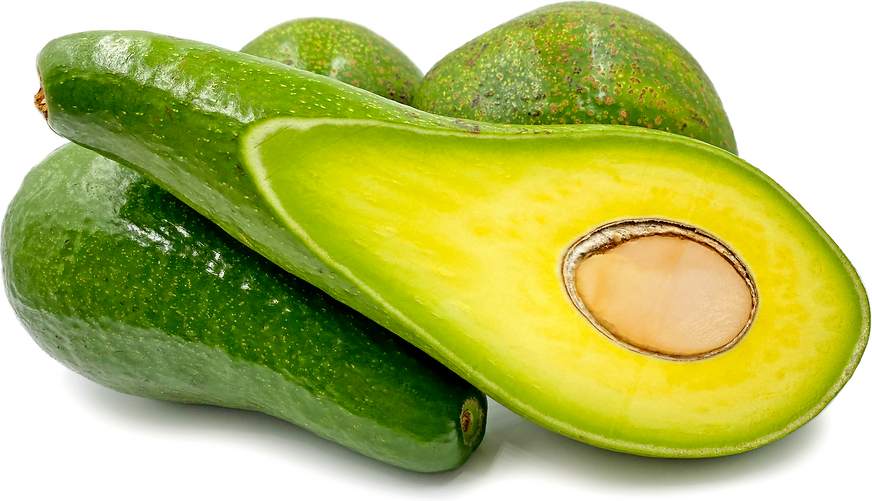


Ugandan Avocados
Estimated Inventory, ea : 0
Description/Taste
Ugandan avocados are genetically diverse and are represented by a wide range of varieties differing in size, shape, color, and flavor. The fruits can be round, oval, elongated, to pear-shape and generally have a bulbous base that slightly tapers into a neck with curved ends. The skin also varies from green to dark purple, almost black, and can be thick to thin, textured, and leathery to glossy. Underneath the surface, the flesh is dense, dry, creamy, aqueous, to fibrous, ranging in color from pale green to yellow-green. Ugandan avocados will exhibit varying flavor profiles, depending on the variety, and are commonly nutty and subtly sweet.
Seasons/Availability
Ugandan avocados are available year-round, with a peak season during the first rainy season of the year in Uganda.
Current Facts
Ugandan avocados, botanically classified as Persea americana, is a general descriptor used for many different avocado varieties belonging to the Lauraceae family. In Uganda, avocados are locally known as Ova, and the fruit trees are widely found across the country, grown by small farms and home gardeners. With this widespread, small-scale cultivation, many new varieties have been created from unrecorded crosses, creating a vast amount of genetic diversity. These locally grown fruits are commonly sold in local markets and are highly favored for their rich flavors, but there is also a movement throughout the country towards increased cultivation for export. Dutch wholesalers have established relationships with Ugandan growers to cultivate and export more well-known avocado varieties to Europe. Ugandan farmers are currently focusing their efforts to cultivate varieties such as semil, reed, fuerte, bacon, and hass, with hass being the most economically profitable and important cultivar as it is a top variety within European markets.
Nutritional Value
Ugandan avocados are an excellent source of potassium, which is a mineral that can help balance fluid levels within the body and are a good source of vitamins A, C, E, and K, magnesium, and folic acid. The fruits are also considered a “nutrient booster” as they enable the body to absorb more fat-soluble nutrients when consumed with other sources.
Applications
Ugandan avocados are best suited for raw applications as the fruit’s smooth, creamy flesh is showcased when sliced and consumed fresh, out-of-hand. The fruits are traditionally served raw in green, fruit, and potato salads, or they can be lightly mashed into wraps and sandwiches. Ugandan avocados can also be mashed into a dip with lemon juice, vermouth, garlic, cayenne pepper, and anchovy fillets and served with potato chips, vegetables, or dried coconut slices. The high-fat content of some Ugandan avocado varieties combines well with acidic fruit and vegetables like tomatoes, creating the well-known kachumbari salad. This mixture of tomato and onion is tossed with cilantro, avocado, and lime juice, and is widely consumed throughout Uganda served with main dishes of rice and grilled meats. Ugandan avocados pair well with peanuts, eggplant, carrots, corn, red onion, meats such as goat, beef, and poultry, cilantro, cinnamon, paprika, plantains, and cassava. The fresh fruits will ripen at room temperature, and once mature, they can be kept for an additional 2 to 3 days in the refrigerator.
Ethnic/Cultural Info
Uganda is known as the “fruit basket” of East Africa and is considered the be the second-largest producer of fruits and vegetables in sub-Saharan Africa. Avocados grow well in the country’s fertile soils and tropical climate, making it a popular tree cultivated in homesteads, small gardens, and compounds. There are many different varieties grown in home gardens, and the fruits have become a common accompaniment to traditional, carbohydrate-centric meals. In Uganda, avocados are seen as a filling and nutritious ingredient and are often sliced and served fresh with rice and beans, bread, pasta, grilled meats, and potatoes.
Geography/History
Avocados are native to southern Mexico and have been cultivated throughout Central and South America since ancient times. With the arrival of European explorers, avocados were then introduced to tropical regions around the world, including Singapore, in the mid-19th century. Avocado varieties were believed to have been brought from Singapore to Uganda in the early 20th century, where they began to be extensively cultivated in the tropical climate. Today Ugandan avocados are primarily grown throughout the northern, western, and eastern regions and are cultivated through small farms, select agricultural research centers, and in home gardens. Ugandan avocados are sold locally in fresh markets and are also exported to Canada, Russia, Egypt, Sweden, Spain, Norway, and Qatar. They are also extensively imported into the Netherlands through Dutch wholesalers and are re-exported into European countries such as the United Kingdom, France, and Germany.




